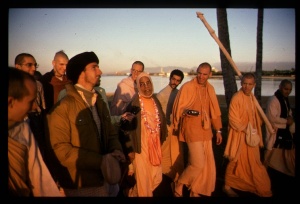SB 4.21.15

A.C. Bhaktivedanta Swami Prabhupada
TEXT 15
- prāṁśuḥ pīnāyata-bhujo
- gauraḥ kañjāruṇekṣaṇaḥ
- sunāsaḥ sumukhaḥ saumyaḥ
- pīnāṁsaḥ sudvija-smitaḥ
SYNONYMS
prāṁśuḥ — very tall; pīna-āyata — full and broad; bhujaḥ — arms; gauraḥ — fair-complexioned; kañja — lotuslike; aruṇa-īkṣaṇaḥ — with bright eyes resembling a morning sunrise; su-nāsaḥ — straight nose; su-mukhaḥ — with a beautiful face; saumyaḥ — of a grave bodily stature; pīna-aṁsaḥ — shoulders raised; su — beautiful; dvija — teeth; smitaḥ — smiling.
TRANSLATION
King Pṛthu's body was tall and sturdy, and his complexion was fair. His arms were full and broad and his eyes as bright as the rising sun. His nose was straight, his face very beautiful and his personality grave. His teeth were set beautifully in his smiling face.
PURPORT
Amongst the four social orders (brāhmaṇas, kṣatriyas, vaiśyas and śūdras), the kṣatriyas, both men and women, are generally very beautiful. As will be apparent from the following verses, it is to be concluded that not only were Mahārāja Pṛthu's bodily features attractive, as described here, but he had specific all-auspicious signs in his bodily construction.
As it is said, "The face is the index of the mind." One's mental constitution is exhibited by his facial features. The bodily features of a particular person are exhibited in accordance with his past deeds, for according to one's past deeds, his next bodily features—whether in human society, animal society or demigod society—are determined. This is proof of the transmigration of the soul through different types of bodies.